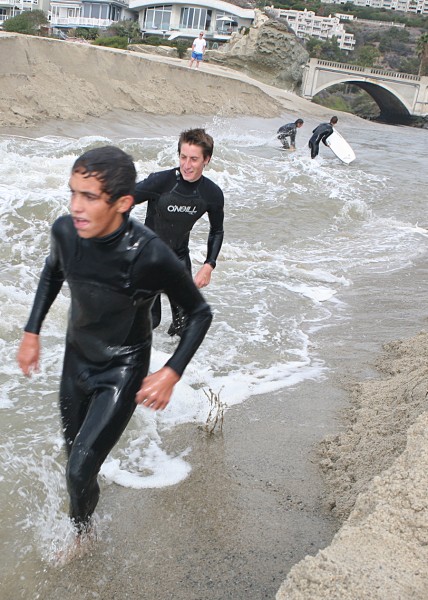
Regulars at south Laguna beaches are noticing what they’re calling a relatively new phenomenon, believed to be borne of urban encroachment: a slow build-up of sand on beaches that’s covering fragile tidepools and curtailing desirable side-swell breaks for wave riders.
Charles “Tex” Haines, a 40-year skimboarder and founder of the Victoria Skimboard company, says beaches are beginning to drown in sand. The extra sediment is doubling the width of some beaches, he said. It’s traveling with water run-off in the now constantly flowing Aliso Creek from upstream communities such as Aliso Viejo and Laguna Niguel onto local beaches and into the Pacific Ocean.
Other nearby cities, such as Newport Beach, are paying millions to dredge up and import sand for waning sandy shores, which threatens to undermine the tourist trade and upset beachfront property owners. But beaches south of Aliso Creek are getting way too much of the sedimentary silt, said Haines.
Some experts concur that Haines’s conclusion, based on anecdotal evidence rather than scientific findings, could be occurring, but others see no evidence of a problem.
The north end of Thousand Steps Beach in South Laguna, “is 100-plus yards wide and I don’t remember it ever being more than 50 when I was growing up, ever,” emphasized Haines, whose company sponsors The Vic, the 37-year-old skimboarding contest at Aliso Beach adjacent to Aliso Creek.
When south Orange County was largely rural without water-dependent lawns and parks, the amount of sandy sediment hitting Aliso Beach would be naturally redistributed by coastal currents, explained Mark Adelson, a senior environmental scientist with the California Regional Water-Quality Control Board.
“With the current scheme of things, where there is perennial flow and sediment delivery,” he said, “it may be that the sediment delivery is now occurring in such a way that there is more sand coming down the system than can be redistributed.”
Once a farming area, the canyon-like seven-mile long Aliso Creek watershed encompassed a riparian stream that flowed only with rainfall and storm water from the Santa Ana Mountains. With the housing development boom there starting in the 1970’s, subsequent increased water run-off and elevated groundwater levels from landscape irrigation, the stream now during every season, rainy or dry.
“What was once a rural stream that only flowed occasionally in response to storm run-off from the mountains, you now have a system that’s running year-round,” said Adelson. “So, it’s behaving differently than it did in its pre-development condition.
“That certainly could wind up changing the nature of near-shore sandbars, it certainly could result in sufficient volumes of sand to actually raise the mouth of the creek such that any tidepools that might be in the area then get covered with sand. That’s a scenario that makes a lot more sense.”
If more sediment is being deposited due to increased run-off from urbanization, the answer, said both Adelson and Haines, is to go back in time to recreate a more natural flow environment.
“We need to learn how to undo some of the damage that we created,” said Adelson, who cites recent work on the Napa River to curtail sediment generated by farming. “Those agricultural practices unintentionally resulted in discharges of lots of sediment that was subsequently washed down the river where it settled out at San Francisco Bay.” The fix, he said, was to show farmers how to keep sediment out of the river and to restore its natural flow and function.
Haines suggests a series of rock jetties upstream that would trap and slow water, allowing it to seep underground, which would filter and clean the water as well.
His hasn’t been the first proposal.
Multiple studies and plans to tame the watershed have surfaced and submerged over the years. The most recent $43-million SUPER (Stabilization, Utility Protection, Environmental Restoration) project, proposed in 2006, sunk without federal funding. At the time, the developer Athens Group was credited with quiet lobbying of federal officials to clear hurdles and coalesce consensus among local entities. Athens and its partners, which planned to redevelop Aliso Creek Inn and Golf Course, recently sold their interest.
Susan Brodeur, senior engineer with Orange County Parks in charge of outlet maintenance such as Aliso Creek, said her department has been bulldozing a waterway from the pond at the mouth of the creek to the ocean for the past 15 years. That’s the same length of time it’s taken for the build-up of sand on south Laguna beaches, contends Haines.
Brodeur said the bulldozing occurs on an as-needed basis to safeguard beachgoers and homeowners from a meandering or rapidly flowing stream and has happened only once so far this year. “Because of urban run-off, the flow upstream needs to be managed now because of more population,” she said.
It was the first time Brodeur said she’s heard that there’s too much sand on any local beach. “The residents at Aliso get so nervous about the beach receding,” she said. “That’s the more common complaint.” She said studies would be needed to provide evidence of the slow build-up of sand. “It’s not like there’s increased flow lately that’s pumping sedimentation,” she said. “It’s a matter of seasonal beach fluctuations that are natural. I don’t think there’s been any study that Aliso Beach is gaining width.”
Haines realizes the poor timing of his plea. “It’s the worst possible time for me to bring this up,” he said. “It’s been a nonstop south swell all summer,” which has carved sand from south-facing beaches and restored the side wave at Thousand Steps. “So I have mud on my face and no one’s going to believe me.”
But it’s temporary, Haines argues, due to seasonal wave surges from storms in Mexico that are eroding sand from local beaches. “Certainly this kind of surf all summer long is not our normal pattern,” he said.




